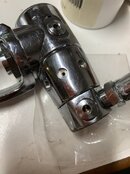I have a good idea on what I consider is the primary reason why the Mk-5 was replaced, but this is only based on a educated technical guess… and I have not confirmed it with anyone at Scubapro. That said, I doubt that there is anyone left at Scubapro that was around when this decision was made, but I don’t really know that.
IMO, the reason had to do with the increase popularity of higher pressure cylinders.
The Mk-5 design in general does not like the higher operating pressure cylinders. I am not referring about the older yokes. Those were replaced over the years, in two stages.
The problem with the Mk-5 with the higher tank pressures is with the high pressure piston O-ring (the small one that seals on the piston shaft). It will have a tendency to be extruded with the higher operating pressures.
There are two traditional ways to avoid O-ring extrusion on a dynamic gland seal.
The best way is by reducing the clearance or gap between the piston and the body. The problem is that this involves tighter tolerances, which is difficult to do when the shaft of the piston has to seal in the main body and the head of the piston has to seal on a separate part that is threaded to the main body.
In a perfect world when the two parts are screwed together, it should all line up and be concentric. But in the real world, then you have to add up fabrication and assembly tolerances.
So the first solution was the MK-10. The two sealing surfaces for the piston in the Mk-10 are machined into one solid metal body. It is all done in one machining setup and the relative tolerances can be very tight. The concentricity of the two sealing surfaces can be dead on.
IMHO, the only disadvantage of the Mk-10 is that the piston head had to be relatively small to fit into a relatively small package. The bigger the piston head, the more stable and constant is the IP (this applies to both balanced and unbalanced piston first stages).
So Scubapro wanted to go back to a bigger piston head.
Some machining processes with tighter tolerances (at a reasonable cost) have improved a little bit through the last few decades, but not as much as many advertise and tend to believe (at least not in this short time period).
The other solution to reduce the extrusion gap is to use an O-ring with a back-up ring. This is the solution that the diaphragm Conshelf regulator used in the high pressure balancing chamber O-ring since the mid 60’s.
I will admit that I am not super familiar with the newer Scubapro regulators (the Mk-15, Mk-20, and Mk-25), but they all look like they incorporate a high pressure piston O-ring with a bushing/ back-up ring configuration. The purpose of this design is to have a tight O-ring support in a floating orifice surface to back the O-ring and avoid extrusion. This is accomplished without the need high precision (or tight tolerances) between the main body and the piston head closing body.
The disadvantage is the need for more parts and complexity (and associated cost). But that is the tradeoff in order to handle the higher pressures.
Many Mk-5 will handle the 3500 psi cylinders just fine, specially with higher durometer O-ring, but IMO, as a company Scubapro could not push its luck.

 125 up and no creep, I’ve had it holding pressure for several hours and no change.
125 up and no creep, I’ve had it holding pressure for several hours and no change.





